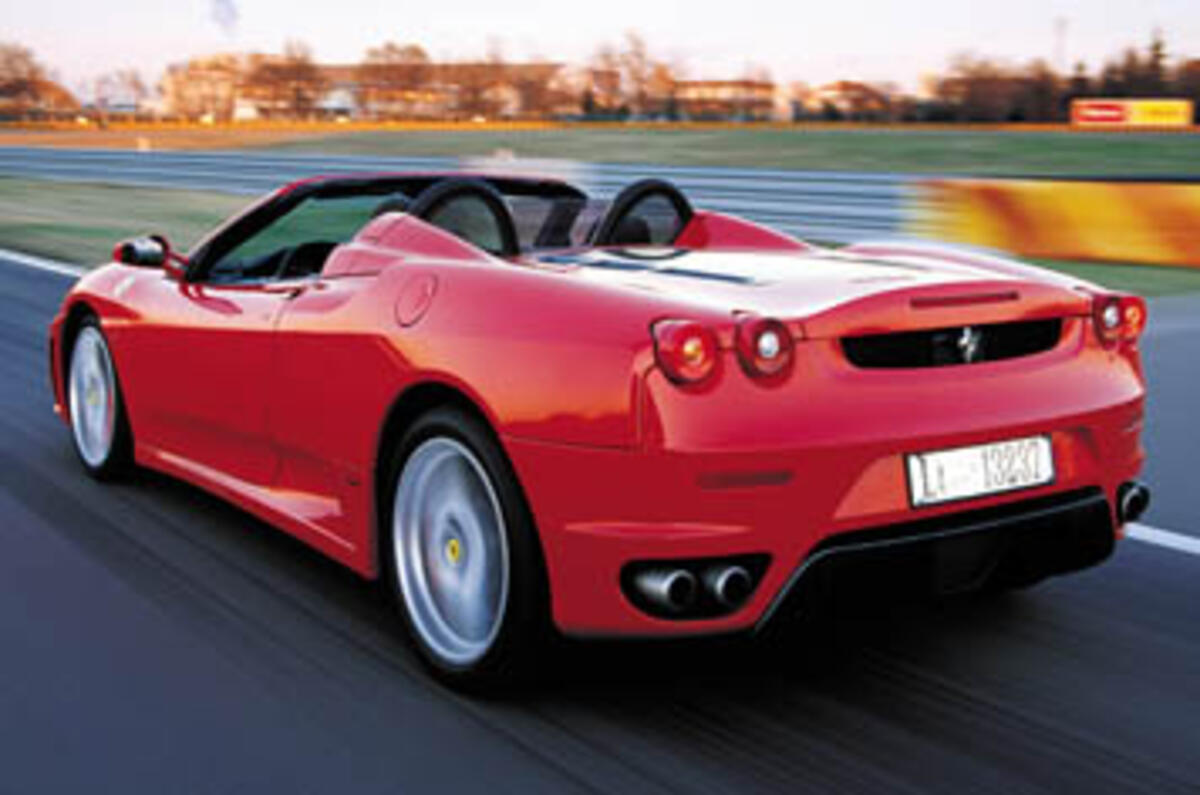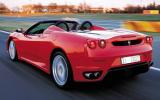This is going to sound daft, but imagine some big organ pipes – the sort of tubes you might find in a church – bubbling air through liquid. Or try to remember when you were five, and discovered that blowing through a straw into your drink was another excellent way to annoy your parents. Well, the satin bubbling noises that resulted are just one of a whole range of sounds that you will hear from the exhaust pipes of a Ferrari F430, which must be the nearest to a musical instrument that a waste disposal system has got to.At a rapid cruise in sixth, it issues a resonant tone that you could almost call a harmony. Make the V8 work from low revs in a high gear, and an electrifying, percussive beat overlays a velvet breathiness that wells to an almost surreal wall of sound. Rev the engine hard – past the 4500rpm mark where the cam timing jolts the Ferrari forward, past 7000rpm when the tacho needle is at a warning 12 o’clock, and on to close-of-play at 8500rpm – and you’ll finally hear the hammering shriek that is a Ferrari driver’s more familiar backing-track. It’s hard to think of a mechanical device with such a full repertoire, apart from an accordion.When you peel the roof from your Ferrari F430, this soundscape is all the more evident. In fact, it dominates your experience with the F430 Spider, though there are plenty of other treasures fighting to distract you. Surveying it before you board is obviously one, and though this Spider is far from the most beautiful of Ferrari roadsters – the shape is too busy for that – it draws the eye like a light in the dark.The busy design is mostly down to the 430’s relationship with the atmosphere: the engine must feed on it to breathe and stay cool, the body must cut through it and harness the stuff to cement itself to the road, and the brakes need its chilling passage during high-speed workouts. Which is why the F430’s body is cut by many a vent, intake and extractor. The most dramatic reside in a front bumper that recalls the famous 1961 sharknose Ferrari 156 F1 car, but when you sit inside and view the door mirrors, you’ll see the meshed air intakes that supply the engine from the rear wings, and if you haven’t worked it out already, their compact, aggressive menace tells you all you need to know about this Ferrari’s intent. Which is road-gobbling, alfresco style.Of course every mid-engined drop-top Ferrari has been able to manage that, but the difference this time is that the F430 Spider is a really serious sports car and not just the poseur’s version of the Coupé. Not the that the outgoing 360 Spider was short of ability, but as we have seen with the closed F430, this Ferrari V8 moves deftly onto a whole new plane of possibility. What’s so impressive is its completeness as a driver’s tool. That begins with performance, as it always does with a Ferrari, and there’s certainly no shortage of it.Mechanically the Spider is identical to the Coupé bar minor repackaging of the air intakes, so there are 483 prancing quadrupeds agitating for an unleashing just aft of your head. The full stampede erupts at 8500 yelling revs, and can drag the Spider to 62mph in 4.1 seconds before levelling off at just over 193mph.They certainly tug with convincing zeal over the first half of the rev range, but it’s when you score 4500rpm that you’re left in no doubt about this engine’s potency. At this point the Ferrari feels like it’s received a sharp shove up the back bumper. The exhaust note intensifies and it surges like an animal in fear of its life, bounding forward with a ferocity that could provoke a rush of fear if the 430 didn’t track with the imperturbability of a high-velocity bullet. Such performance excitements are down to the effects of variable valve timing, and an exhaust bypass valve that dramatically alters the timbre of the system from 3000rpm, just in case you think there isn’t enough drama already.You can still manage these high-performance outpourings with a manual transmission, but most buyers will opt for the F1 sequential gearshift, a major improvement on the outgoing 360’s system. Clutch life should be longer, and the electronics that control shift quality have now got most situations licked. And there’s no question that the paddle-shift is a speedier and more convenient means of exchanging ratios – a new gear is a mere finger-flick away, and mostly, you only need to feather the throttle to ensure a tremor-free change. Only up-shifts on a trailing throttle fox it. True, you don’t have the challenge of managing clutch, throttle and gearlever, but be assured that you’ll have plenty else to deal with on a tight, twisting road, as confirmed during a swift trip up one of Ferrari’s favourite test routes 10 minutes out of Maranello. The Ferrari bounds from corner to corner like a starved leopard on the chase, giving you plenty to think about in the braking and steering departments. And that isn’t because the whole thing turns wayward, either.Ferrari’s E-diff is the key to the F430’s mid-corner magic, this electronically controlled parceller of power enabling twists to be taken with driver-flattering deftness. Not that it does it all for you – with this much power it’s quite possible to come to a turn too fast, but in sport mode the diff and its electronics maintain traction, minimise understeer and assist in the creation of that fast-flowing fluency that keen drivers dream of. And you can add more drama to the mix by twisting the steering wheel-mounted dial to the race setting, which will allow you a modest angle of dangle, but without threatening an expensive and embarrassing rotation.You also have the traditional insurance of powerful brakes, our test car coming with optional carbon-ceramic discs. They make faint grating noises at low speeds but boy, can you lean on them. You can smell them when you do, too, a hot musk rather different from what we’re used to – a little like spent fireworks, suggested photographer Papior.Does all this back-up take the challenge out of a charge? Absolutely not. You’ve got more than enough power to perform a regrettable assault on the scenery, and more than enough to adjust the Ferrari’s line with the throttle, despite those electro-hydraulic ministrations. But best of all is the F430’s steering. It’s as direct as the Ferrari is obedient, of course, and the weighting is just so. The wheel doesn’t jig with quite the free motion of a Lotus Elise’s – the hydraulic assistance is a little glutinous for that – but it certainly tugs and writhes enough to tell you about the road below. It is tactile back-chat like this that is an essential in any car claiming to be a real sports car.And so, of course, is a stiff body. Otherwise you get shake, shimmy, creak and twitter, sometimes all at the same time, but most of all you get the disappointment of realising that your wheeled beauty bends under pressure. So it’s a measure of the Spider’s stiffness that only once did I think about it when I detected a faint shudder in the screen during a high-speed corner. But 99 per cent of the time you never think about it. That means that you’re riding a platform upon which the suspension can bear and resist the structural loosenings that lesser sportsters suffer with age.Not that this Ferrari is entirely free of faults. There’s too much wind rustle around the door tops on the motorway, although Matteo Lanzavecchia, who led the Spider’s development, says that there are adjusters in the roof system that may allow this to be dialled out (our test car is a pre-production example) and that exhaust, amusing though it is at first, can turn a bit wearing at a cruise. Lanzavecchia has an answer to this, too – switch the dial to the wet setting, and the exhaust bypass valve opens further up the rev range, dulling the V8’s blare at a cruise. Which it does, but we reckon it’s still too loud for long distances. A shame, because this Ferrari is a surprisingly effective motorway car, and not simply because it can bolt from one traffic cluster to the next in a nanosecond. Terrific directional stability – so you aren’t endlessly steering it – impressively pliant suspension and a comfortable seat make it a smooth ride, although taller drivers may find the driving position too high. And yes, Lanzavecchia has an answer for that – order the sports buckets, which are mounted lower.Running with the roof down is entirely pleasant even on a cold winter’s day, and we certainly had that in Maranello, much of the hillier countryside layered with a thick coat of snow. But the roads were dry, allowing us to confirm that at 110mph, for instance, you will feel no more than a light eddying of air around your head, the result of mesh wind-blockers in the roll-over bars, and a rather cheap and scratch-prone Plexiglass windbreak between those twin hoops. Since the roof folds electrically – seven actuators and a clever folding mechanism will have it packaged away below the rear deck in 20 seconds – there’s no excuse for running roof up if the conditions are remotely clement.Such packaging is a major feat. You only need press the button for the furl/unfurl operation, the roof locking to the screen top without human assistance, the whole lot concertina-ing away so tightly that you wonder how a hood could be stowed below that rear deck, especially since it shares the space with a sizeable engine. And as a final flourish, you can still view the V8 through a glass lid, as with the Coupé.Not that you’ll be seeing that from the inside, your high-performance residence providing a satisfying mix of luxury, utility and style. Luxury comes at you with all that leather, whose matt satin finish looks good enough to lick. It encases everything from pillars to seats to centre console to door casings, and can flood the cabin with colour if you go for something bright. Immaculately cut carpets, splashes of aluminium, a beautifully wrought wheel, precision-look instruments and exquisite eyeball airvents all provide a visual feast. The utlility is in the controls, which are sited just so, and the fact that, like every Ferrari past, you only get what’s necessary and nothing to confuse. And there’s no question that this cabin has that slightly spare style that makes a Ferrari look classy, though I’d go for the aluminium decor rather than carbonfibre, the black weave reminiscent of a Mercedes cabin that’s trying too hard.But it’s this Ferrari’s completeness that’s most satisfying of all, and final proof of that comes on a road so puckered that I slow down to 25mph to protect the car. Except that 10 seconds later I’m doing 40mph and more over it, because the suspension is supple, so compliant, that the Ferrari can soak all this stuff up without a crash, bang or thud. There are plenty of executive cars that would be more troubled smoothing away this road, but this supercar is having no trouble at all. And it’s this rounded ability that marks the F430 out as such a complete car, a car capable not just on the streaking, sinuous roads that it was made for, but in the real world, too. That is some achievement – and this is some car.
Open goal
Close
Back to top

















Add your comment